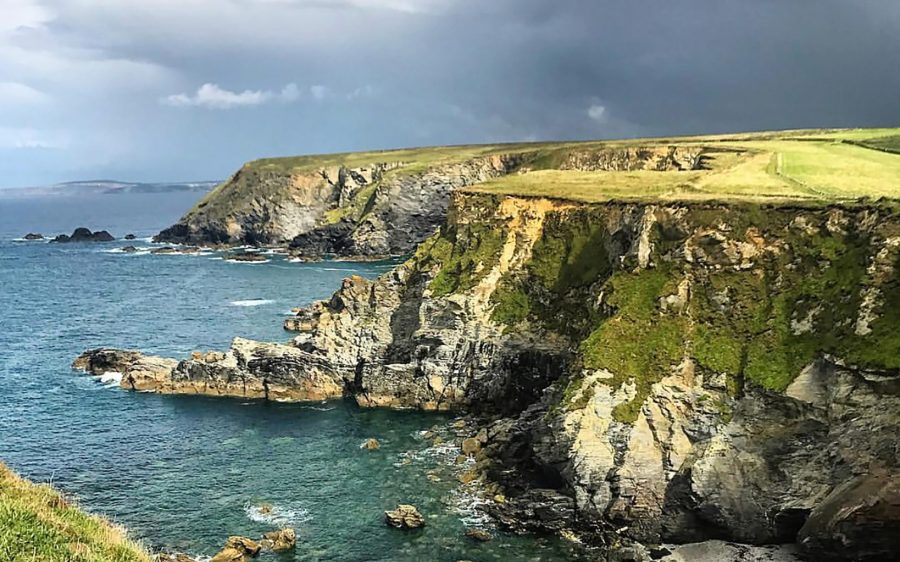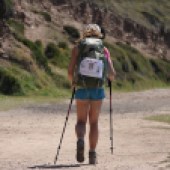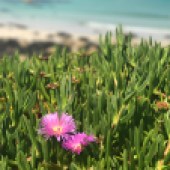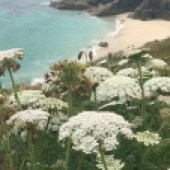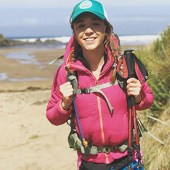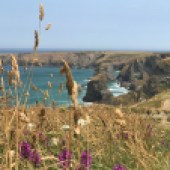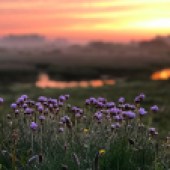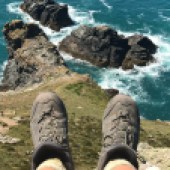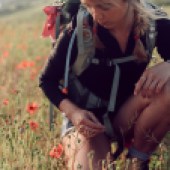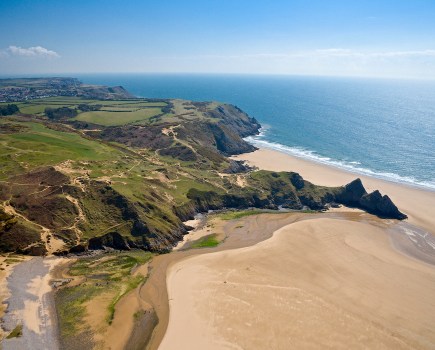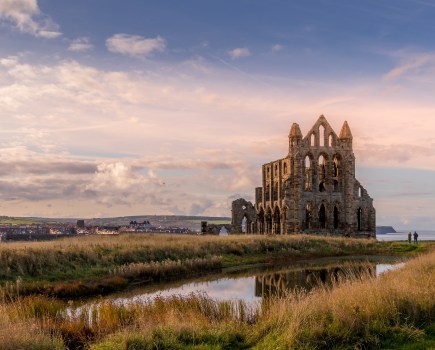Photographs: Tim Pavelle and Sophie Pavelle
Day 13 of 22. It’s mid-afternoon and I’m on the wild side of Porthleven, watching storm clouds roll in. I’m flustered, dehydrated and engaged in a fierce debate with myself as to whether I should push on another 13 miles to Lizard Point, where a bed and shower await. Suddenly snapping into the present, realising my deliberations are wasting time, I square my shoulders, ram in the headphones and trudge on. It’s a rare moment of doubt in the last 150 miles, signalling my dwindling motivation and lack of confidence in my commitment to persevere with my goal, to make a 300-mile long trek along the Cornish section of the South West Coast Path while recording its wildlife and natural beauty for an audience of social media users.
Across the beach and on to the footpath, I’m demoralised that I haven’t seen enough wildlife to create an engaging vlog (video blog) this evening. But rounding the headland puts me nose to beak with a huge cormorant, airing its wings in the wind. Sun rays suddenly shoot through a charcoal cloud, revealing a fleeting iridescence on this magnificent bird’s plumage. Headphones discarded, eyes peeled, below a gannet swoops in the turbulence above the sea, commanding the waves with such precision and elegance that my feet stop throbbing as I grab my iPhone. Enthusiasm bubbles happily from my reserve supply as I begin to present my vlog – a medium made for moments like this.
OPERATION COAST
Being outside, searching for wildlife, and using these ventures to connect with the visually hungry audience on social media is what I like doing. It all began with a proposition – how to translate my passion for the wild, beautiful British coast into a legitimate MSc Science Communication research project? ‘I know!’ I thought back in January 2017. ‘I’ll trek 300 miles around the Cornish coast, and call it “science communication”!’ Needling my stubborn streak, naysayers only fuelled my desire to successfully execute my plan. With plastic polluting even our most pristine environments and screen time at an all-time high in our increasingly couch-potato nation, the environmental messages I wanted to spread were urgent and timely. And where better to test this, than on one of the most spectacular and best-loved coastlines in the world.
Deciding that the gnarly north coast was best tackled first, I planned my route anti-clockwise along the South West Coast Path from Bude to Plymouth, marking the Cornwall-Devon border. Starting in the surfer’s paradise of wild, windy Bude, and armed with a 12kg backpack and my extensive camera kit of an iPhone, selfie stick and £3.99 eBay tripod, I set off on 11 June 2017. The first few days were experimental. I felt daunted by the fact I’d set myself the physical challenge of hiking 300 miles solo, negotiating 12 to 25 miles every day, along with the digital challenge of creating engaging daily content online.
STRIDING OUT
Cornwall in June is as picturesque as its terrain is gruelling and unforgiving. As a hiker, I relished the opportunity of walking for 22 days, challenging my physical and mental grit during an intense heatwave. From relentless sun exposure to feeling totally isolated in driving rain, on terrain that rivalled alpine trails, it was not always fun. But the wildlife was plentiful, and the scenery beautiful, and it was those sights that kept me going. June is a perfect time to hike, as the wild flora and emerging butterflies set the path ablaze with colour and vitality. West Pentire Head, for example, is nationally important for sustaining a rich invertebrate population and rare coastal flora such as wild poppies.
I soon became used to the north coast’s dramatic climbs and rocky terrain. Leaving the comforting charm of Padstow behind on my fifth day, I was astounded at the wild beauty of The Rumps on Pentire Point – a stunning group of headlands shortly before the path wends its way back to Polzeath. It is here that I glimpsed my first gannet, Europe’s largest seabird, plummeting into the blue at a mind-numbing 100kmph as it feeds. Joined by grey seals, kittiwakes, guillemots, razorbills and choppy azure waters, I couldn’t contain my excitement at the hustle below.
As I continued south, the climate became more temperate. Reaching the geological marvel that is the Lizard Peninsula is like a walk through time, surrounded by massive outcrops of ‘moho’, the world famous serpentine rock that should be 20km below my feet in the Earth’s mantle, but has instead been subject to incomprehensible tectonic forces and uplifted. I’m amazed at the microcosm of biodiversity that thrives alongside this landscape – so different from the weathered granite scenes further north. Luminous yellow lichen smothers these black rocks, nature’s beacon for signalling the unrivalled air quality at the bottom of the British Isles.
COASTAL CARROTS
If I thought too much about the overall distance, I would wobble. Instead, I set myself daily goals of climbing that cliff, walking around another headland and safely reaching my destination, which made for lots of little accomplishments and complete immersion in the landscape – an escape. I loved how nature doesn’t care what you look like or where you come from, it simply rewards these efforts – an amazing view at the top, or a group of seals, a fiery sunset all to yourself.
There is just ‘something about Cornwall’ became my mantra. Home to more than 60 nature reserves and 160 Sites of Special Scientific Interest (SSSIs), many of which are along the coast path, my wildlife expectations were high. Seeing a basking shark was top of my list as they are often seen cruising the Cornish coast for plankton in early summer; despite my best efforts I didn’t see any. What I wasn’t prepared for was Cornwall’s immense diversity of other coastal wildlife. Most days I had ‘bottling’ grey seals for company, poking their heads out of the water like eager puppies, and often spotted peregrine falcons hunting.
The soundscape to my journey was one of crashing sea-spray and blowy westerly winds, accompanied by the sweet song of skylarks on the cliff-tops, the cat-like call of buzzards riding the thermals, and the cries of guillemots, razorbills and kittiwakes galore. Diligent pollinators worked the untamed borders, while wary, wild Exmoor ponies mused at my progress from a distance. I began to crave the almost daily dose of kestrels, each time astounded by their precision and focus in maintaining a hover as they orientate themselves into the wind, eyes fixed.
REACHING OUT
Leading up to the trek I’d promoted it on social media with the help of organisations such as The Wildlife Trusts and Ordnance Survey to gain the online following needed for my research to gather data. My walk is an experiment, to test how social media can be used effectively to communicate messages about our environment, wildlife and conservation – little did I know how keen people are to engage with this kind of content. Once I found my feet and established a daily filming and editing routine, my heart was totally in it. I was amazed at the momentum my daily vlogs and posts gathered online, averaging a reach of more than 2,000 people per day. I took encouragement in the genuine curiosity and enthusiasm for our coasts shown by people following my trek from all corners of the globe.
Despite my exhaustion, I revelled in the intense calm and clarity of thought I felt each day. Having wildlife and the environment as my sole focus was a tonic, and all the motivation I needed to carry on. I was also fired up by the lack of young people enjoying the trail, amused that I often seemed to be the youngest person walking the coast path by a good 30 years. Encountering plastic bottles, discarded straws, cutlery and cotton buds in areas where wildlife flourishes further convinced me that inspiring affection for our coastal environment and empathy for nature is a message worth spreading.
As much as I wanted to curl up and rest, my 22 evenings were spent pacing around youth hostels, hanging out of windows and sitting on top of windswept tufts searching for a signal to edit and post each vlog in real time. My spirits lifted when my parents gallantly joined me for a couple days – my dad walking with me from Mawgan Porth to Portreath, my mum meeting me at the triumphant halfway mark of Land’s End. Neither will I forget the hospitality and warmth of those I met on the path or stayed with, leaving each place feeling cheered and revived. My favourites were YHA Tintagel, Boswinger and Lizard Point – who gave incredible support and comfort to me during my journey. Mary, a lovely lady who welcomed me into her airbnb near Pendeen at the last minute, gave me the most pampered 12 hours of cake, tea and cheese I could ever have hoped for. I fully immersed myself in local Cornish culture, history and cuisine, continually adding to my already high Cornish pasty count.
A LESSON LEARNED
I cannot stress enough the joy I found in the relationship between being outside and allowing that to nurture an empathy for the natural world. I challenge anyone to spend time on our coastlines, feel the power of the waves and the weather and not catch that bug. A hunger grows to see as much as you can, to feed the curiosity that brews. I often found myself asking total strangers, ‘Did you see that buzzard just then?’ or ‘How crazy was that kestrel back there?’ Even if I did get odd looks and sympathetic smiles sometimes, my excitement about the UK’s immense biodiversity was bubbling.
Crossing the finish line with my boyfriend who joined me on the last leg to Edgcumbe on 2 July, 2017, I felt bewildered that it was all over. Physically I was drained – I’d lost some weight, my digestion was awry from the trail diet and I felt tired. But I’d gained strength and scars that I’m proud of still. Mentally I was elated, emotional, already nostalgic for the coastline that had become my temporary home. Being immediately interviewed by ITV Westcountry forced me to reflect on the last three weeks, the last 22 videos and the thousands of people who followed my every step online and who, I hope, felt inspired to experience it for themselves.
On reflection, Sophie’s Wild Cornwall allowed me to realise my potential, going solo on testing terrain and honing my determination to do something different from many of my peers. Exploring this special coastline offered me a chance to reflect on our place in its future. If we encourage people to develop a relationship with the coast they are more likely to protect it – and I believe that social media can play a hugely important role in helping to foster this. My research from the trip is in the process of being published in a science communication journal, and in between day hikes and Devon wildlife-watching, I’m planning more trips – the next to Scotland’s stunning north coast – to continue my epic, eye-opening journey.
For more information on Sophie see her YouTube channel, or follow her on Instagram at @Sophiepavs
Need to know
• If you’d like to follow in Sophie’s footsteps and explore the Cornish section of the South West Coast Path for yourself, Trailblazer’s ‘Cornwall Coast Path SW Coast Path Part 2 – Bude to Plymouth’ is an excellent, travel-size guide to the trail. It has 142 large-scale detailed maps and guides to the 81 towns and fishing villages you will encounter along the way, including places to stay and refuel.
• For a breathtaking overnight experience with unrivalled views of the rugged north coast, stay at YHA Tintagel. Uniquely situated on its own headland next to the coast path, it offers a warm welcome and accommodation within walking distance from the castle and the village.
• The picturesque towns of Padstow and Boscastle are also within easy reach by car or bus. If you’re feeling strong, the next leg towards Port Isaac has some of the more strenuous sections of the path – but also some of the most rewarding! Browse and book at yha.org.uk.

